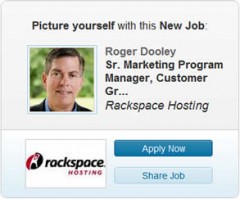Forget Evil, Don’t Be Creepy!
Three Ways to Avoid Creepiness

Marketers are being offered unprecedented new capabilities to target consumers by interests and behavior. There’s growing evidence, though, that consumers are finding these personalized pitches off-putting. A new survey of UK social media users showed that nearly half “don’t like having ads targeted to them based on information included in their social media profiles, including activities, interests, and other personal data.” While Google’s motto has been, “Don’t Be Evil,” perhaps a more appropriate one would be, “Don’t Be Creepy!”
The positive spin, I suppose, is that the other half is fine with personalized ads, but this high level of negative sentiment has to be troubling to marketers who are counting on targeting and personalization to improve the effectiveness of their ads. I’ve been advocating personalization via social media and other means lately, and I believe there are ways to reduce the probability that consumers will find targeted pitches creepy instead of appealing.
Target: Don’t Over-Personalize
I highly recommend an excellent New York Times article by Charles Duhigg, How Companies Learn Your Secrets, which uses Target as a case study of how companies can mine behavioral data to gain startling insights about consumers. Target, for example, was able to predict which female customers were pregnant and when they were likely to deliver by seemingly unrelated purchasing patterns for products like lotion. (In one case, an angry father complained to Target about the mother-to-be offers sent to his daughter, only to apologize later when the daughter told her family she was indeed pregnant.) As you can imagine, the potential creepiness factor with such accurate targeting is high.
What did Target do? They broadened their offers for these unannounced mothers-to-be to include a variety of other products so that the baby-related deals looked incidental and normal. This eliminated the, “How do they know? I haven’t told anyone!” problem while still presenting the consumer with highly relevant products.
Online merchants could learn from this. I’m finding that sites like Overstock.com and Amazon.com are sending followup emails after I’ve browsed a product on their site. I’m used enough to retargeted ads that appear on other sites that I don’t find these emails overly problematic. But, I think they might be more successful if the slipped the product into a broader mailing that featured sales prices on various other products, too. Instead of a neutral reaction to a mailing reminding me that I looked at something but didn’t buy it, I think I’d have more of an “Aha!” reaction when I spotted the familiar item that was now on sale… “Hey, that watch I looked at the other day is on sale now!” (Both firms do something like that already, as far as I can tell.)
Ask for Permission
 I highlighted some excellent social and other personalization efforts by colleges and universities in my Get Schooled post.
I highlighted some excellent social and other personalization efforts by colleges and universities in my Get Schooled post.
Certainly, seeing your image, or your friends’ photos, appearing on a website has some creep potential, but these schools all defuse that by asking permission in some way. St. Bonaventure, on their site Becoming Extraordinary,  invites visitors to connect with Facebook for a personalized experience; the site is still perfectly usable without the social login.
invites visitors to connect with Facebook for a personalized experience; the site is still perfectly usable without the social login.
Similarly, the video sites I described, like Adler’s, ask the student to enter his/her name in order to personalize the video. In all of these cases, seeing one’s name or photo is fun, not creepy, because it’s expected and voluntary. Finding the personalized content can even become a sort of Easter egg hunt which is rewarded multiple times during the experience.
Stay Positive
 One of the experiences that launched my personalization series was spotting my face in a LinkedIn job ad for a specific employer. I was surprised, but not offended or creeped out. I think that’s because the ad was positive in nature – me, hypothetically filling a vaguely relevant role in a quality company.
One of the experiences that launched my personalization series was spotting my face in a LinkedIn job ad for a specific employer. I was surprised, but not offended or creeped out. I think that’s because the ad was positive in nature – me, hypothetically filling a vaguely relevant role in a quality company.
LinkedIn could see this strategy go wrong, for example, if they observed an individual update their work history to show their position at their current employer stopping but with no new employer starting. If they peppered that individual with ads like, “Need a Job?” or “Get Sacked?” they would likely create plenty of negativity. In the same way, if a non-profit targeted donors with a Facebook photo and a caption like, “Are you starving, Roger? These children are,” the message might be powerful but it likely create some bad vibes among the targeted viewers.
Fails Ahead?

If you don’t want to be that company, think before you personalize. As yourself, “How could this go wrong?” And, if you can’t think of a way, ask a few creative friends who don’t have anything invested in the project. (Target should consider itself lucky it didn’t have to deal with a headline like, “Woman beaten after store ad reveals pregnancy, husband arrested.”) If you spot a potential snag, don’t give up. Just redesign the offer or rewrite the message. In just about every case, you should be able to find a way to personalize the offering without being either offensive (or creepy)!
